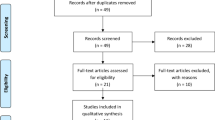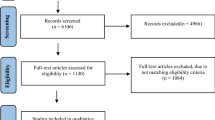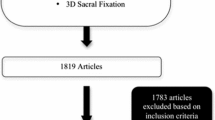Abstract
Purpose
Robot-assisted pelvic screw fixation is a new technology with promising benefits on intraoperative outcomes for patients with posterior pelvic ring injuries. We aim to compare robot-assisted pelvic screw fixation to the traditional fluoroscopy-assisted technique with regards to intraoperative and postoperative outcomes.
Methods
The Preferred Reporting Items for Systematic Reviews and Meta-Analyses (PRISMA) guidelines were used along with a search of electronic information to identify all studies comparing the outcomes of robot-assisted versus conventional screw fixation in patients with posterior pelvic ring injuries. Primary outcomes included operative duration (minutes), intraoperative bleeding (mL), fluoroscopy exposure and intraoperative drilling frequency. Secondary outcome measures included Majeed score, healing time (minutes) and rate (%), postoperative complications, screw positioning, incision length (cm) and guide wire insertion times (minutes). The random effects model was used for analysis.
Results
Four observational studies including a total of 294 patients were identified. There was a significant difference between robot-assisted and conventional groups in terms of operative duration (MD = − 24.66, p < 0.05), intraoperative bleeding (MD = − 10.37, P < 0.05), fluoroscopy exposure (MD = − 2.15, P < 0.05) and intraoperative drilling frequency (MD = − 2.42, P = < 0.05). For secondary outcomes, no significant difference was seen in Majeed score, healing time and rate and postoperative complications. The robot-assisted group had better screw positioning, smaller incision length, and shorter anaesthesia and guide wire insertion times.
Conclusions
Robot-assisted fixation has superior intraoperative outcomes compared to conventional fixation. Further studies are needed to look at postoperative outcomes as there is no significant difference in postoperative prognosis between the techniques.







Similar content being viewed by others
Data availability
The datasets generated and analysed during the current study are available from the corresponding author on reasonable request.
References
Pereira GJC, Damasceno ER, Dinhane DI, Bueno FM, Leite JBR, da Ancheschi B, C, (2017) Epidemiology of pelvic ring fractures and injuries. Rev Bras Ortop 52:260–269. https://doi.org/10.1016/j.rboe.2017.05.012
Failinger MS, McGanity PL (1992) Unstable fractures of the pelvic ring. J Bone Joint Surg Am 74:781–791
Kim W-Y (2014) Treatment of Unstable Pelvic Ring Injuries. Hip Pelvis 26:79–83. https://doi.org/10.5371/hp.2014.26.2.79
Routt ML, Nork SE, Mills WJ (2000) Percutaneous fixation of pelvic ring disruptions. Clin Orthop Relat Res. https://doi.org/10.1097/00003086-200006000-00004
Banaszek D, Starr AJ, Lefaivre KA (2019) Technical Considerations and Fluoroscopy in Percutaneous Fixation of the Pelvis and Acetabulum. J Am Acad Orthop Surg 27:899–908. https://doi.org/10.5435/JAAOS-D-18-00102
Iorio JA, Jakoi AM, Rehman S (2015) Percutaneous Sacroiliac Screw Fixation of the Posterior Pelvic Ring. Orthop Clin North Am 46:511–521. https://doi.org/10.1016/j.ocl.2015.06.005
Eastman JG, Chip Routt ML (2015) Correlating preoperative imaging with intraoperative fluoroscopy in iliosacral screw placement. J Orthopaed Traumatol 16:309–316. https://doi.org/10.1007/s10195-015-0363-x
Templeman D, Schmidt A, Freese J, Weisman I (1996) Proximity of iliosacral screws to neurovascular structures after internal fixation. Clin Orthop Relat Res. https://doi.org/10.1097/00003086-199608000-00023
Thakkar SC, Thakkar RS, Sirisreetreerux N, Carrino JA, Shafiq B, Hasenboehler EA (2017) 2D versus 3D fluoroscopy-based navigation in posterior pelvic fixation: review of the literature on current technology. Int J CARS 12:69–76. https://doi.org/10.1007/s11548-016-1465-5
Zwingmann J, Konrad G, Mehlhorn AT, Südkamp NP, Oberst M (2010) Percutaneous Iliosacral Screw Insertion: Malpositioning and Revision Rate of Screws With Regards to Application Technique (Navigated Vs. Conventional). J Trauma Injury Infection Critical Care 69:1501–1506. https://doi.org/10.1097/TA.0b013e3181d862db
Krappinger D, Lindtner RA, Benedikt S (2019) Preoperative planning and safe intraoperative placement of iliosacral screws under fluoroscopic control. Oper Orthop Traumatol 31:465–473. https://doi.org/10.1007/s00064-019-0612-x
Galetta MS, Leider JD, Divi SN, Goyal DKC, Schroeder GD (2019) Robotics in spinal surgery. Ann Transl Med. https://doi.org/10.21037/atm.2019.07.93
Wu X, Wang J, Sun X, Han W (2019) Guidance for the Treatment of Femoral Neck Fracture with Precise Minimally Invasive Internal Fixation Based on the Orthopaedic Surgery Robot Positioning System. Orthop Surg 11:335–340. https://doi.org/10.1111/os.12451
Moher D (2009) Preferred Reporting Items for Systematic Reviews and Meta-Analyses: The PRISMA Statement. Ann Intern Med 151:264. https://doi.org/10.7326/0003-4819-151-4-200908180-00135
Meera Viswanathan, Mohammed T Ansari, Nancy D Berkman, Stephanie Chang, Lisa Hartling, Melissa McPheeters, Lina Santaguida, Tatyana Shamliyan, Kavita Singh, Alexander Tsertsvadze, Jonathan R Treadwell (2008) Assessing the Risk of Bias of Individual Studies in Systematic Reviews of Health Care Interventions. In: Methods Guide for Effectiveness and Comparative Effectiveness Reviews
Wang J-Q, Wang Y, Feng Y, Han W, Su Y-G, Liu W-Y, Zhang W-J, Wu X-B, Wang M-Y, Fan Y-B (2017) Percutaneous Sacroiliac Screw Placement: A Prospective Randomized Comparison of Robot-assisted Navigation Procedures with a Conventional Technique. Chin Med J 130:2527–2534. https://doi.org/10.4103/0366-6999.217080
Liu H, Duan S, Liu S, Jia F, Zhu L, Liu M (2018) Robot-assisted percutaneous screw placement combined with pelvic internal fixator for minimally invasive treatment of unstable pelvic ring fractures. Int J Med Robotics Comput Assist Surg 14:e1927. https://doi.org/10.1002/rcs.1927
Long T, Li K, Gao J, Liu T, Mu J, Wang X, Peng C, He Z (2019) Comparative Study of Percutaneous Sacroiliac Screw with or without TiRobot Assistance for Treating Pelvic Posterior Ring Fractures. Orthop Surg 11:386–396. https://doi.org/10.1111/os.12461
Wang J, Zhang T, Han W, Hua K, Wu X (2020) Robot-assisted S2 screw fixation for posterior pelvic ring injury. Injury. https://doi.org/10.1016/j.injury.2020.11.044
Wells G, Shea B, O’Connell D, Peterson J, Welch V, Losos M, Tugwell P The Newcastle-Ottawa Scale (NOS) for assessing the quality of nonrandomised studies in meta-analyses
Zhu Z-D, Xiao C-W, Tan B, Tang X-M, Wei D, Yuan J-B, Hu J, Feng L (2021) TiRobot-Assisted Percutaneous Cannulated Screw Fixation in the Treatment of Femoral Neck Fractures: A Minimum 2-Year Follow-up of 50 Patients. Orthop Surg 13:244–252. https://doi.org/10.1111/os.12915
Müller MC, Belei P, Pennekamp PH, Kabir K, Wirtz DC, Burger C, Weber O (2012) Three-dimensional computer-assisted navigation for the placement of cannulated hip screws. A pilot study International Orthopaedics (SICOT) 36:1463–1469. https://doi.org/10.1007/s00264-012-1496-7
Cheng H, Chen BP-H, Soleas IM, Ferko NC, Cameron CG, Hinoul P (2017) Prolonged Operative Duration Increases Risk of Surgical Site Infections: A Systematic Review. Surg Infect 18:722–735. https://doi.org/10.1089/sur.2017.089
Matityahu A, Marmor M, Elson JK, Lieber C, Rogalski G, Lin C, Belaye T, Miclau T, Kandemir U (2013) Acute Complications of Patients With Pelvic Fractures After Pelvic Angiographic Embolization. Clin Orthop Relat Res 471:2906–2911. https://doi.org/10.1007/s11999-013-3119-z
Artoni C, Pogliacomi F, Guardoli L, Lasagni F, Leigheb M, Fontanesi F, Calderazzi F, Pompili M, Vaienti E, Ceccarelli F (2019) Pelvic ring fractures: what about timing? Acta Biomed 90:76–81
Duan S, Liu H, Wu W, Yang K, Zhang Z, Liu S (2019) Robot-assisted Percutaneous Cannulated Screw Fixation of Femoral Neck Fractures: Preliminary Clinical Results: Robot assisted Fixation of Femoral Neck Fractures Robot - assisted Percutaneous Screw Fixation of Femoral Neck Fractures. Orthop Surg 11:34–41. https://doi.org/10.1111/os.12430
Liu H, Duan S, Xin F, Zhang Z, Wang X, Liu S (2019) Robot-assisted Minimally-invasive Internal Fixation of Pelvic Ring Injuries: A Single-center Experience: Single-Center Experience. Orthop Surg 11:42–51. https://doi.org/10.1111/os.12423
Negrín R, Duboy J, Reyes NO, Barahona M, Iñiguez M, Infante C, Cordero JA, Sepulveda V, Ferrer G (2020) Robotic-assisted Unicompartmental knee Arthroplasty optimizes joint line restitution better than conventional surgery. J EXP ORTOP 7:94. https://doi.org/10.1186/s40634-020-00309-8
Funding
The author(s) received no financial support for the research, authorship and/or publication of this article.
Author information
Authors and Affiliations
Contributions
AN is the first author of this paper. Study concept and design was by AN. AN and AS were involved in analysis and interpretation of data. OM and AG took part in data acquisition. MAB and IA took part in supervision. All authors contributed to drafting the manuscript. All authors read and approved the final manuscript.
Corresponding author
Ethics declarations
Conflict of interests
The author(s) declared that they have no competing interests.
Additional information
Publisher's Note
Springer Nature remains neutral with regard to jurisdictional claims in published maps and institutional affiliations.
Appendices
Appendix 1
See Table
Appendix 2
Search criteria
(Computer-assisted) AND (robo-) AND (fractur-).
(iliosacral) AND (computer-assisted) AND (fractur-).
(iliosacral) AND (computer-navigated) AND (fractur-).
(iliosacral) AND (robo-).
(lumbopelvic) AND (robo-).
(machin-) AND (pelvi-) AND (fractur-).
(pelvi-) AND (computer-assisted) AND (fractur-).
(pelvi-) AND (computer-navigated) AND (fractur-).
(Pelvi-) AND (robo-) AND (fractur-).
(percutaneous) AND (sacroiliac) AND (scre-).
(robo-) AND (posterior) AND (ring).
(sacr) AND (fracture) AND ((computer- assisted) OR (computer assisted) OR (robo-) OR (computer-navigated) OR (computer navigated)).
(sacroiliac) AND (computer-navigated) AND (fractur-).
(Sacroiliac) AND (robo-).
(screw) AND (pelvi-) AND (robo-).
(screws) AND (pelvi-) AND (robo-).
(ROBOT)
Rights and permissions
About this article
Cite this article
Al-Naseem, A., Sallam, A., Gonnah, A. et al. Robot-assisted versus conventional percutaneous sacroiliac screw fixation for posterior pelvic ring injuries: a systematic review and meta-analysis. Eur J Orthop Surg Traumatol 33, 9–20 (2023). https://doi.org/10.1007/s00590-021-03167-x
Received:
Accepted:
Published:
Issue Date:
DOI: https://doi.org/10.1007/s00590-021-03167-x




